If you remove the differential pan cover and notice water in the differential, you might wonder how it leaked in and what to do about it. We recommend catching the differential fluid in a container that allows you to see any mixture in the fluid, so even if you’re not experienced at identifying a discrepancy in the differential fluid, you’ll still notice water or other fluids. If you find water in the rear differential, we review how it happens, how to fix it, and how to catch early warning signs before the axle housing and rear differential collects water and causes drivability problems like binding or noises from the rear differential.
What Happens If Water Is in the Differential?

Rusted and Damaged Internal Gears
If water leaks inside the differential, rust or debris can damage the internal gears. You can tell if the gears are damaged by lines and scuff marks on the gears, and by chunks of the gear missing if the damage is that bad.
Binding or a Chattering Noise at the Rear
Gears with rust could cause a binding noise, or chattering when driving.
How Does Water Get in the Differential?
Driving in Wet Conditions
Driving through rough conditions like water, like towing a boat and backing down into a lake, or navigating areas that collect a lot of puddles can create opportunities for water to leak into the differential. The differential isn’t completely sealed. Pressure in the differential builds up from movement or heat. As the differential cools, a breather hose on top helps it depressurize.
Damaged Vent Hose
Water can get in through a vent hose if it is damaged like ripping or no clamp. If it is loose, this creates an opportunity to let in moisture.
A clip will also hold a vent hose up higher, and if it detaches and the hose falls, it can take in moisture. It should also have a one-way valve and not be wide open, so if the valve is missing, it can also take in moisture.
Damaged Pinion, Axle, and Differential Seals
Moisture can also seep in through seals like the pinion seal. If gear oil is leaking from the pinion seal, moisture can also leak in.
Axle seals behind each wheel can also let in moisture.
The differential cover seal can also leak. In this example, the original seal is installed, but someone also installed gasket maker. This “double-gasket creation” caused a discrepancy and allowed moisture to sneak in.
Will Moisture Accumulate in Other Areas Than the Differential?
Moisture will probably be in the axle housing if it is also in the differential. To fix this, you can lift the vehicle from one side and tip it. This will send fluid to the center where it can be drained. Once one side has been drained, do the same for the other.
How to Inspect a Differential for Water and Fix It
Steps to inspect and fix a differential with a water leak
- Remove Fluid from the Differential
If you suspect there is water in the differential, first drain any fluid from the differential. It might help to take a sample of the fluid. You should be able to see the fluid separate from water in a separate container if it is contaminated.
- Inspect the Gears for Damage like Rust, Scraping, or Chunks Missing
Check the differential gears and bearings for damage or rust. A light coating of rust is not a big concern, but if there’s a large coating or chunks, the differential needs cleaning.
Bearings along with gears spin in the differential when the axles do. There are bearings on each side of the differential, and toward the front of the differential, near the driveshaft. There are also bearings at each end of the axle housing. Rust in the bearings can create noise and binding over time.
- Check Where the Leak Came From
Inspect the ends of the axle housing, the sides, front, and the differential pan seal for leaks. Leaking creates an opening for moisture to leak in.
Read more on how to inspect a differential for leaking - Clean the Differential
The larger gear will spin when the driveshaft is turned. It will be hard since there are a lot of teeth to clean on the gear, but it’s necessary to remove any noise.
- Fix Leaking Areas
Areas like the axles or pinion seal leaking will need to be fixed. The seals will need to be replaced before adding more fluid.
- Add More Differential Fluid
Once the areas leaking have been identified and fixed, use manfucaturer specified fluid and refill the differential
Free Shipping No Minimum on Quality Auto Parts
How-to Videos: Learn to Do More Than Inspect Water in the Differential
Our how-to videos have instructions by mechanics to help you diagnose and replace tons of parts. Find out how to do more repairs than fix water in a differential with expert tips that apply to specific models and many vehicles in general.
Shop Parts and Tools
- Brakes & Wheel Bearing
- Steering & Suspension
- Headlights & Lighting
- Exterior, Body Parts & Mirrors
- Heating & Cooling
- Tools & Accessories
Read More Tips
- Ceramic vs. Semi-Metallic Brake Pads: Which Is Better? Brake Pad Types and Rotors Explained
- Bad Lower Ball Joint Symptoms? How to Check Front Lower Ball Joints with a Dial Indicator
- Common 4.0 Liter Jeep Engine Problems on the 1984 to 2001 Cherokee
- What are the Different Types of Fuel Injection Systems?
- What is The Difference Between Flat Plane and Cross Plane Crankshafts?
- The Top 5 Chevy Silverado Problems: 2nd Generation (2007 to 2014)







